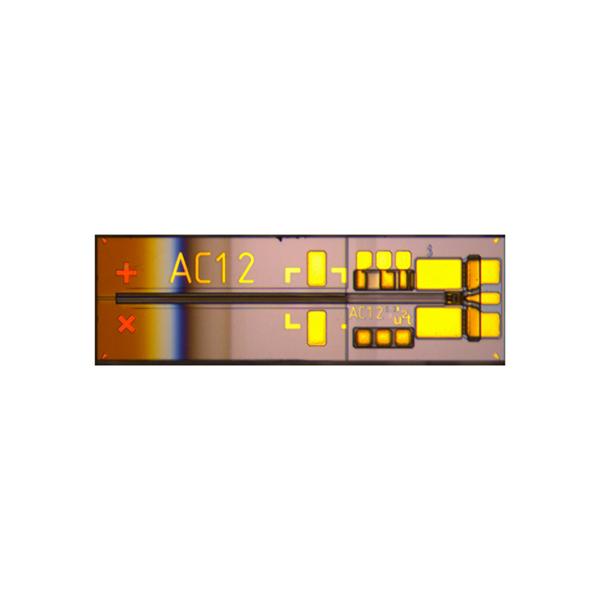Networking
High-Speed Photodetectors and Receivers
Choose from 100+ model options with speeds from 18 GHz to 100 GHz designed for O-, C-, or dual-band operation and advantages such as high gain or high linearity.
Whether your application is long-haul, DWDM, microwave photonics, high-speed (up to 100 GHz) lightwave characterization, or lab equipment for testing & measurement up to 1 Tb/s, get the ideal photodetector for your needs from an industry leader with decades of experience.
High-Speed Photodetectors – Product Line Overview
Specify your options. Connectors include FC/PC (standard) as well as FC/PAC, Custom V® and custom options. Choose between single- or dual-band operation for some models.
- 18 GHz Gain Limiting Photoreceiver
- 20 GHz Ultra-High-Power Photodetector
- 30 GHz High Gain Photoreceiver
- 43 GHz Balanced Photodetector
- 50 GHz High Speed Photodetector
- 50 GHz High-Power Photodetector
- 70 GHz Balanced Photodetector (BPDV3x20RV)
- 70 GHz High Speed Photodetector
- 100 GHz Balanced Photodetector
- 100 GHz High Speed Photodetector
Model Numbers |
Product Type |
Key Features |
Key Specifications |
Operating Band |
Typical Applications |
Photo Photodetectors (PIN) |
|||||
BPDV412xRv |
100 GHz Balanced Photodetector |
Two 100 GHz photodiodes on a single chip Linear frequency response |
Bandwidth >100 GHz Integrated bias |
C |
|
XPDV412xR |
100 GHz High Speed Photodetector |
Every unit characterized in both frequency and time domains |
100 GHz typical electrical 3 dB bandwidth |
C |
|
BPDV3x20Rv |
70 GHz Balanced C or Dual-Band Photodetector |
Balanced C and/or dual-band operation Two photodiodes on a single chip |
70 GHz typical bandwidth Integrated bias |
C or dual (O and C) versions |
|
XPDV3x20R |
70 GHz High Speed Photodetector |
Single 70 GHz photodiode |
70 GHz bandwidth with flat response Integrated bias |
C or dual (O and C) versions |
|
XPDV2xx0Rv |
50 GHz High Speed Photodetector |
Optimized frequency response in both amplitude and phase |
50 GHz typical bandwidth with flat response Integrated bias |
C or dual (C and O) versions |
|
HPDV2120R |
50 GHz High-Power Photodetector |
High power handling MMI coupler divides signal across 4 photodiodes |
High linearity: OIP3 > 20 dBm @ 40 GHz |
C |
|
BPDV21x0R |
43 GHz Balanced Photodetector |
Two waveguide-integrated photodiodes on a single chip |
>40 GHz bandwidth at 3dB PDL <0.5 dB |
C |
|
VPDV2120 |
20 GHz Ultra-High-Power Photodetector |
Linear response Based on a modified uni-traveling carrier (MUTC) photodetector chip |
Responsivity >0.55 A/W OIP3 >30 dBm @ 10 GHz |
C |
|
Photo Photoreceivers (PIN+TIA) |
|||||
XPRV2324A |
18 GHz High Gain Limiting Photoreceiver |
Contains a waveguide-integrated PIN-photodiode and auto-adjusting TIA |
Typical gain: 900 V/W AC coupled output |
O and C |
|
XPRV2325A |
30 GHz High Speed Photoreceiver |
Integrated TIA supporting both manual and automatic gain control |
Adjustable gain from 25 to 1800 V/W Supports AC output |
O and C |
|
Related Products
Featured Blog
SiC Circuitry Makes EVs Better
Coherent is one of the few companies worldwide with a complete, vertically integrated SiC manufacturing capability. We produce SiC wafers and epitaxy, all the way through power devices and modules. Furthermore, the unmatched quality with which we can produce SiC material makes Coherent virtually the only supplier positioned to successfully transition from the current standard wafer diameter of 150 mm up to 200 mm.
Featured Success Story
Augsburg University: Excimer Laser Optics Facilitate Fluence Control
A team led by Prof Helmut Karl at Augsburg University chooses a COMPex laser and bespoke PLD beam optics for quantitative ablation studies of single-crystalline targets.








